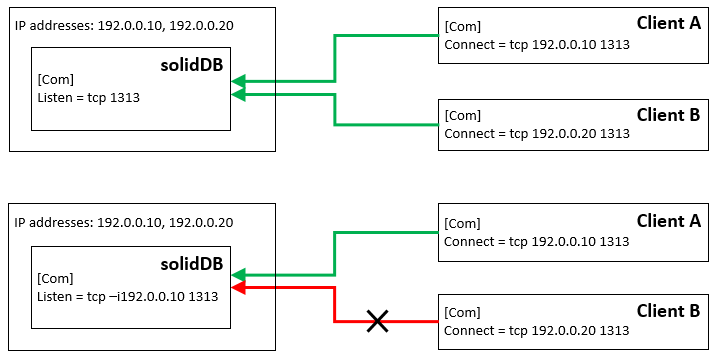|
Option
|
Description
|
Protocol
|
|---|---|---|
|
-4
|
Specifies that solidDB listens to IPv4 protocol only.
|
TCP/IP or TLS
|
|
-6
|
Specifies that solidDB listens to IPv6 protocol only.
In Windows environments, this option is mandatory if IPv6 protocol is used.
|
TCP/IP or TLS
|
|
-iip_address|
host_name |
solidDB listens for client connections on only the specified address or host name.
Listening to a specified IP address or host name is useful in multi-homed systems that support many TCP/IP interfaces or have multiple IP addresses.
For example, the following diagram shows two scenarios. In each case, the solidDB process is running on a computer that has two IP addresses.
In the first scenario, when the -i parameter is not used, both Client A and Client B can connect to solidDB.
In the second scenario, the -i parameter sets a specific IP address for connections, and so Client B, which is not attempting to connect on the specified IP address, cannot connect to solidDB.  Host name can be used instead of IP address, for example: [Com] Listen = tcp -ilocalhost 1313 |
TCP/IP or TLS
|
|
-ofilename
|
Turns on the network trace facility and defines the name of the trace output file.
See Troubleshooting for details.
|
All
|
|
-plevel
|
Sets the highest level at which the clients can use the solidDB Ping facility.
For example, if the server side is set to -p3, clients applications can run the Ping facility at levels 1, 2, and 3, but not at 4 and 5.
SeeTroubleshooting for details.
|
All
|
|
-t
|
Turns on the Network trace facility.
See Troubleshooting for details.
|
All
|